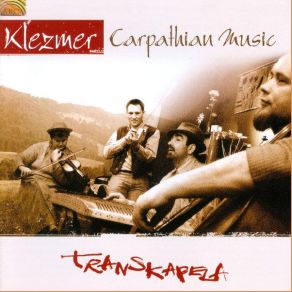Klezmer Carpathian Music
Download links and information about Klezmer Carpathian Music by Transkapela. This album was released in 2007 and it belongs to World Music genres. It contains 16 tracks with total duration of 01:06:52 minutes.

|
|
|---|---|
| Artist: | Transkapela |
| Release date: | 2007 |
| Genre: | World Music |
| Tracks: | 16 |
| Duration: | 01:06:52 |
| Buy it NOW at: | |
| Buy on iTunes $9.99 | |
Tracks
[Edit]| No. | Title | Length |
|---|---|---|
| 1. | Old-time Sirba | 4:31 |
| 2. | Chasydzki Weselny | 4:31 |
| 3. | Sirba-Friska | 1:46 |
| 4. | Zsidos z Gyimes | 1:23 |
| 5. | Livezile | 4:09 |
| 6. | Kolomyjka | 5:16 |
| 7. | Stetl Tango | 2:20 |
| 8. | Hora mare din Bucovina | 4:08 |
| 9. | Forshpil and Khusidlekh | 5:53 |
| 10. | Taniec (zsido) "Sztajerek dziadka Jozka" / Taniec (zsido) "Krakowiaczek" / Hanuka | 4:21 |
| 11. | Walc Meritz'a | 4:53 |
| 12. | Taniec (zsido) "Cygan" | 3:56 |
| 13. | Nuta besarabska | 0:38 |
| 14. | Nuta bukowinska - od Mohura | 6:05 |
| 15. | Hora Kandel'a | 2:36 |
| 16. | Honga Transkapela | 10:26 |
Details
[Edit]A nice collection of jumping, bounding klezmer in its various forms from the Carpathian regions, Klezmer Carpathian Music is similar in many ways to what's usually simply called Polish klezmer, as there's a good deal of overlap in the regions. The album opens with a quick Transylvanian fiddle number then starts moving throughout the region quickly. Wedding dances come from Galicia, a reworking of the Hungarian czardas makes very heavy work of the hammered dulcimer, and some roots music from the mountain area of Gyimes is added to the mix. Romanian, Ukrainian, and more Transylvanian music comes along for the ride, including a bit of a tango as it were (with hints of classic rock influences). Some horas help the group round the corner, followed by waltzes and a cygan. The album closes out with more straightforward klezmer music, violins flaming. There are plenty of scratchy, traditional klezmer recordings out there to be heard, recorded in the heyday of the Eastern European immigrations. There's also plenty of modern klezmer with various twists to the delivery, to the instrumentation, to the composition. This band walks the line between the two relatively well — they play essentially only traditional pieces, but liven them up a bit — and perhaps more importantly, they use some higher quality recordings.